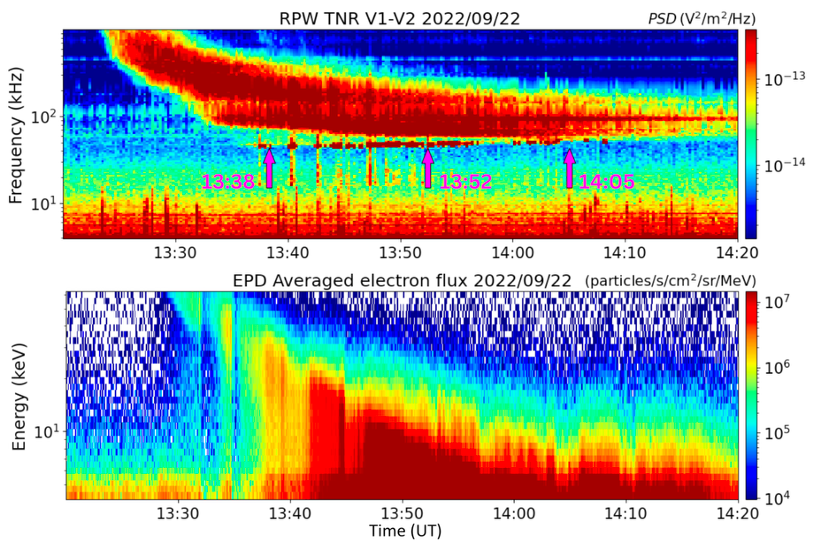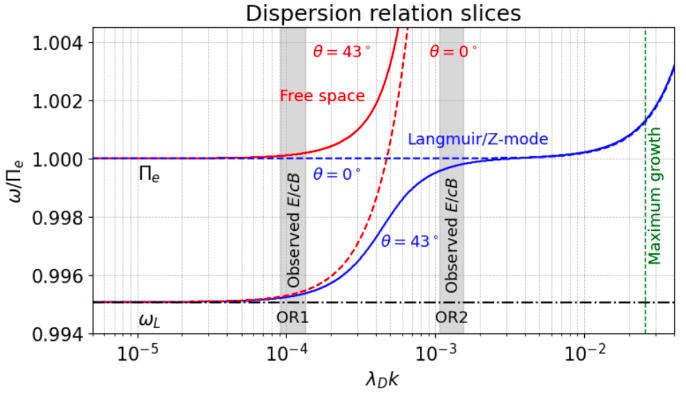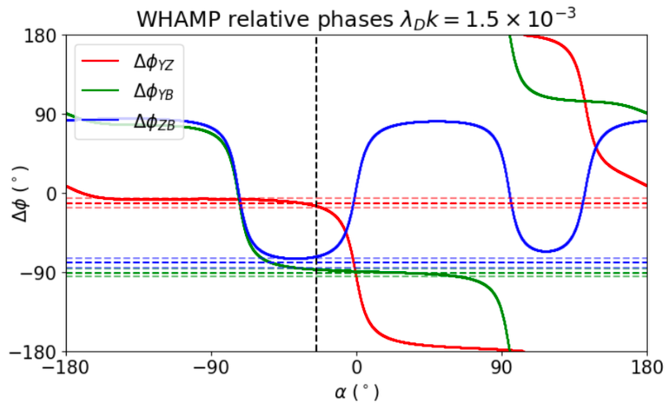Type III solar radio bursts are generated by beams of energetic electrons propagating through interplanetary space. These electron beams, released from the Sun, travel along the Parker spiral and grow Langmuir waves through a kinetic instability in the electron velocity distribution function. The generated Langmuir waves subsequently undergo mode conversion, producing a radio emission at the plasma frequency or its harmonic.
Langmuir waves are electrostatic waves generating the electric field fluctuations along the local magnetic field line. As reported by Malaspina et al., (2011), and others, transverse electric fields have also been observed during in situ type IIIs, suggesting that the observed waves are not always purely electrostatic in nature. As suggested by Krauss-Varban, (1989), the polarization of such waves could be explained by the generalized Langmuir/Z-mode with oblique wave vectors. These waves also have a magnetic component, which was first reported by Scarf et al., (1970) from OGO 5 observations and more recently confirmed by PSP (Larosa et al., 2022). In our paper (Formanek et al., 2025), we present the first polarization analysis that includes a magnetic component of Langmuir/Z-mode waves as observed by Solar Orbiter during an in situ type III burst.

Figure 1. In situ observations during the analyzed type III event. Top: spectrogram of the radio emission and Langmuir waves, highlighting three selected time intervals. Bottom: measurement of the electron beam by the EPD SupraThermal Energetic Particles (STEP) sensor.
Polarization analysis
We focus on the in situ type III radio burst observed on September 22, 2022, as depicted in Figure 1. Using the Radio and Plasma Waves (RPW) Time Domain Sampler (TDS), we analyze waveforms of two electric field components and one magnetic field component. Additionally, the electron velocity distribution was measured by the Solar Wind Analyser’s (SWA) Electron Analyser System (EAS) and the Energetic Particle Detector’s (EPD) SupraThermal Electron and Proton sensor. These observations are also crucial for our polarization analysis because they provide the necessary input to a dispersion relation solver, which we used to obtain a theoretical prediction for the wave polarization.
In Figure 2, we show the dispersion relation and highlight two wave number intervals (OR1 and OR2), where the amplitude ratio of the observed electric and magnetic components matched the theoretical solution. By inspecting the relative phases between components (shown in Figure 3), only one of them (OR2) matches the observed polarization.

Figure 2. Dispersion relation of the Langmuir/Z-mode and the free space L-O mode with wave vectors parallel (dashed lines) and at an angle θ=43° (full lines) from the magnetic field. Regions highlighted in gray correspond to the observed ratio E/cB of the electric and magnetic fields.
Conclusions
The observed waveform showed a transverse electric component with an elliptical polarization and a coherent magnetic field component. Our results confirm that the observed wave polarization is consistent with an obliquely propagating Langmuir/Z-mode at low wave numbers. The dispersion relation solution indicates that a beam-driven instability can directly excite wave growth at oblique wave vector angles. While several mechanisms can be responsible for the subsequent reduction in wave vector magnitude, a possible mechanism to reach the observed polarization is propagation through density gradients.

Figure 3. Comparison of the observed and predicted relative phases between components. The dashed lines show the observed relative phases between the Ey, Ez, and BMF components. The full lines show the theoretical prediction for a wave vector in the OR2 interval as a function of the azimuthal angle $\alpha$ of the wave vector.
Additional info
Based on the recent paper by Formánek, T. et al., 2025, Polarization Analysis of Type III Langmuir/Z-mode Waves with Coherent Magnetic Component Observations by Solar Orbiter, ApJL, Volume 985, Issue 2 DOI: 10.3847/2041-8213/add687
Author contact: formanek@ufa.cas.cz
References
Formánek, T.; Santolík, O.; Souček, J. et al.: 2025, ApJL, Volume 985, Issue 2
Krauss-Varban, D.: 1989, JGR, Vol. 94, Issue A4
Larosa, A.; Dudok de Wit, T.; Krasnoselskikh, V. et al.: 2022, ApJ, Volume 927, Issue 1
Malaspina, D. M., I. H. Cairns, and R. E. Ergun: 2011, Geoph. Res. Lett., 38, L13101
Scarf, F. L. ; Fredricks, R. W. ; Green, I. M. et al.: 1970, JGR, Vol. 75, Issue 19
